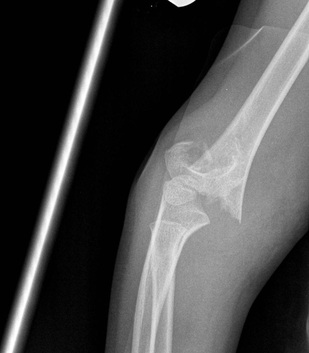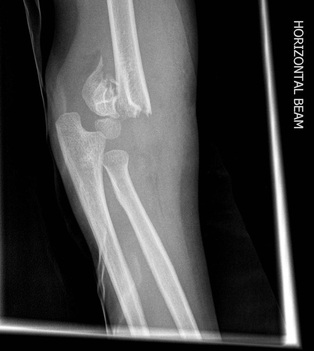A classic paediatric injury which can have catastrophic consequences.
A 5 year old boy falls off a trampoline and presents with the injury shown below. What must be assessed and what are the principles of management?
Do you know any guidelines that help in decision making?
A 5 year old boy falls off a trampoline and presents with the injury shown below. What must be assessed and what are the principles of management?
Do you know any guidelines that help in decision making?
Immediate assessment and management
Is the injury open or closed?
It is crucial to examine the motor and sensory components of the radial, ulna and median (including the anterior interosseous) nerves. In young children it is often easier to ask them to give you the thumbs up and the "OK" sign.
Distal perfusion needs to be assessed including the presences of pulses, warmth and capillary refill
Early surgical treatment is needed for displaced fractures
Emergency surgery is necessary if the limb perfusion is impaired or skin viability is threatened. The vascular team should be informed if the limb is pulseless or cold, and reduction needs to be performed as soon as possible. Perfusion normally recovers once the fracture is reduced.
Immobilise the arm in a backslab for comfort until surgery.
Gartland classification:
Type I - Nondisplaced - anterior humeral line intersects the capitellum, an intact olecranon fossa, no medial or lateral displacement.
Type II - Partially displaced - usually fragment is extended but not completely translated with some cortical contact. The anterior humeral line does not intersect the capitellum. Some rotational displacement and tilt into varus may be present. Subdivision:
IIa - minimally displaced, no rotation
IIb - rotational deformity
Type III - Displaced - circumferential break in the cortex with displacement of the fracture fragments. The distal fragment is generally displaced posteriorly with the metaphyseal fragment impaled into the brachialis muscle and anterior soft tissues.
Types IIb and III nearly always need reduction and fixation with K-wires.
Further Reading / Guidelines
The British Orthopaedic Association have recently brought out BOAST number 11 describing the standards of care for paediatric supracondylar fractures.
Is the injury open or closed?
It is crucial to examine the motor and sensory components of the radial, ulna and median (including the anterior interosseous) nerves. In young children it is often easier to ask them to give you the thumbs up and the "OK" sign.
Distal perfusion needs to be assessed including the presences of pulses, warmth and capillary refill
Early surgical treatment is needed for displaced fractures
Emergency surgery is necessary if the limb perfusion is impaired or skin viability is threatened. The vascular team should be informed if the limb is pulseless or cold, and reduction needs to be performed as soon as possible. Perfusion normally recovers once the fracture is reduced.
Immobilise the arm in a backslab for comfort until surgery.
Gartland classification:
Type I - Nondisplaced - anterior humeral line intersects the capitellum, an intact olecranon fossa, no medial or lateral displacement.
Type II - Partially displaced - usually fragment is extended but not completely translated with some cortical contact. The anterior humeral line does not intersect the capitellum. Some rotational displacement and tilt into varus may be present. Subdivision:
IIa - minimally displaced, no rotation
IIb - rotational deformity
Type III - Displaced - circumferential break in the cortex with displacement of the fracture fragments. The distal fragment is generally displaced posteriorly with the metaphyseal fragment impaled into the brachialis muscle and anterior soft tissues.
Types IIb and III nearly always need reduction and fixation with K-wires.
Further Reading / Guidelines
The British Orthopaedic Association have recently brought out BOAST number 11 describing the standards of care for paediatric supracondylar fractures.


 RSS Feed
RSS Feed
